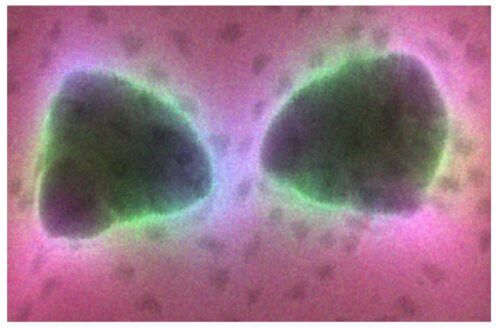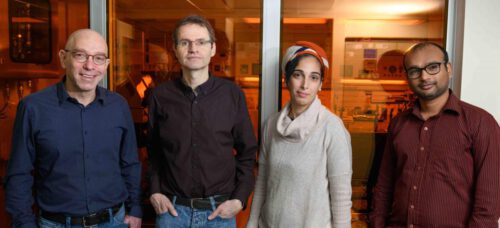The difference between matter and light may seem simple and clear, but in certain situations, the relationship between the two and the interrelationships between them may obscure it to a great extent. Such situations may occur in a nanometer metal antenna, which is aimed at receiving light in the wavelengths of light visible to the human eye. Prof. Gilad Haran from the Department of Chemical and Biological Physics, and the members of his group, built such an antenna - a kind of two "funnels" that point their narrow end towards each other (similar to the structure of a bow tie). The light absorbed by the two funnels is concentrated in the area where they meet and creates a strong electric field

The experimental system, which includes a tiny metal antenna (the two greenish "triangles") and light-emitting particles scattered around it. Photographed with an electron microscope
The difference between matter and light may seem simple and clear, but in certain situations, the relationship between the two and the interrelationships between them may obscure it to a great extent. Such situations may occur in a nanometer metal antenna, which is aimed at receiving light in the wavelengths of light visible to the human eye. Prof. Gilad Haran from the Department of Chemical and Biological Physics, and the members of his group, built such an antenna - a kind of two "funnels" that point their narrow end towards each other (similar to the structure of a bow tie). The light absorbed by the two funnels is concentrated in the area where they meet and creates a strong electric field.
The scientists placed in the meeting area a crystal of a tiny substance that can absorb the light - and emit light back. Prof. Haran says that in the area where the absorption and emission of light takes place, a "strong coupling" is created so that the light particles, the photons, create new states with the material that some call "polaritons". In the experiment carried out by Prof. Hearn and his group members, the scientists used an extremely powerful electron microscope, one of the two "Titan" microscopes recently installed at the institute, to also examine polaritons that do not emit light.
This research may help, in the future, in the development of quantum applications, as well as in the development of methods for controlling chemical processes and shaping the properties of various materials."

The electron beam of the "Titan" allowed scientists, for the first time, to scan the tiny antennas, measure the scattering of electrons at each point and examine the effect of the light-absorbing crystal on the scattering in the center of the antenna. In this way, they were able to map with great precision - and spectral spatial resolution - the coupling between light and matter.
The scientists say that the new ability developed in this research, published in the scientific journal Nature Communications, may help, in the future, in the development of various quantum applications, as well as in the development of methods for controlling chemical processes and shaping the properties of various materials.
The electrons in the "Titan" microscope can move at a speed that is up to 80% of the speed of light.
